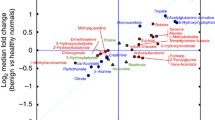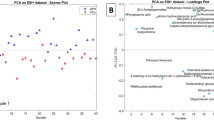ABSTRACT
Background
Pancreatic ductal adenocarcinoma (PDAC) is an aggressive malignancy with poor prognosis in part due to the lack of early detection and screening methods. Metabolomics provides a means for noninvasive screening of tumor-associated perturbations in cellular metabolism.
Methods
Urine samples of PDAC patients (n = 32), healthy age and gender-matched controls (n = 32), and patients with benign pancreatic conditions (n = 25) were examined using 1H-NMR spectroscopy. Targeted profiling of spectra permitted quantification of 66 metabolites. Unsupervised (principal component analysis, PCA) and supervised (orthogonal partial-least squares discriminant analysis, OPLS-DA) multivariate pattern recognition techniques were applied to discriminate between sample spectra using SIMCA-P+ (version 12, Umetrics, Sweden).
Results
Clear distinction between PDAC and controls was noted when using OPLS-DA. Significant differences in metabolite concentrations between cancers and controls (p < 0.001) were noted. Model parameters for both goodness of fit, and predictive capability were high (R 2 = 0.85; Q 2 = 0.59, respectively). Internal validation methods were used to confirm model validity. Sensitivity and specificity of the multivariate OPLS-DA model were summarized using a receiver operating characteristics (ROC) curve, with an area under the curve (AUROC) = 0.988, indicating strong predictive power. Preliminary analysis revealed an AUROC = 0.958 for the model of benign pancreatic disease compared with PDAC, and suggest that the cancer-associated metabolomic signature dissipates following RO resection.
Conclusions
Urinary metabolomics detected distinct differences in the metabolic profiles of pancreatic cancer compared with healthy controls and benign pancreatic disease. These preliminary results suggest that metabolomic approaches may facilitate discovery of novel pancreatic cancer biomarkers.



Similar content being viewed by others
REFERENCES
Bilimoria KY, Bentrem DJ, Ko CY, et al. Validation of the 6th edition AJCC Pancreatic Cancer Staging System: report from the National Cancer Database. Cancer. 2007;110:738–44.
Hidalgo M. Pancreatic cancer. N Engl J Med. 2010;362:1605–17.
Bathe OF, Shaykhutdinov R, Kopciuk K et al. Feasibility of identifying pancreatic cancer based on serum metabolomics. Cancer Epidemiol Biomarkers Prev. 2011;20:140–7.
Klein AP, Hruban RH, Brune KA, et al. Familial pancreatic cancer. Cancer J. 2001;7:266–73.
Greer JB, Lynch HT, Brand RE. Hereditary pancreatic cancer: a clinical perspective. Best Pract Res Clin Gastroenterol. 2009;23:159–70.
Lynch HT, Fitzsimmons ML, Smyrk TC, et al. Familial pancreatic cancer: clinicopathologic study of 18 nuclear families. Am J Gastroenterol. 1990;85:54–60.
Brentnall TA. Management strategies for patients with hereditary pancreatic cancer. Curr Treat Options Oncol. 2005;6:437–45.
German JB, Hammock BD, Watkins SM. Metabolomics: building on a century of biochemistry to guide human health. Metabolomics. 2005;1:3–9.
Fang F, He X, Deng H, et al. Discrimination of metabolic profiles of pancreatic cancer from chronic pancreatitis by high-resolution magic angle spinning 1H nuclear magnetic resonance and principal components analysis. Cancer Sci. 2007;98:1678–82.
Napoli C, Sperandio N, Lawlor RT, et al. Urine metabolic signature of pancreatic ductal adenocarcinoma by (1)h nuclear magnetic resonance: identification, mapping, and evolution. J Proteome Res. 2012;11:1274–83.
Nishijima T, Nishina M, Fujiwara K. Measurement of lactate levels in serum and bile using proton nuclear magnetic resonance in patients with hepatobiliary diseases: its utility in detection of malignancies. Jpn J Clin Oncol. 1997;27:13–7.
OuYang D, Xu J, Huang H, Chen Z. Metabolomic profiling of serum from human pancreatic cancer patients using 1H NMR spectroscopy and principal component analysis. Appl Biochem Biotechnol. 2011;165:148–54.
Sugimoto M, Wong DT, Hirayama A, et al. Capillary electrophoresis mass spectrometry-based saliva metabolomics identified oral, breast and pancreatic cancer-specific profiles. Metabolomics. 2010;6:78–95.
Urayama S, Zou W, Brooks K, Tolstikov V. Comprehensive mass spectrometry based metabolic profiling of blood plasma reveals potent discriminatory classifiers of pancreatic cancer. Rapid Comm Mass Spectrom. 2010;24:613–20.
Wen H, Yoo SS, Kang J, et al. A new NMR-based metabolomics approach for the diagnosis of biliary tract cancer. J Hepatol. 2010;52:228–33.
Slupsky CM, Rankin KN, Wagner J, et al. Investigations of the effects of gender, diurnal variation, and age in human urinary metabolomic profiles. Anal Chem. 2007;79:6995–7004.
Eisner R, Stretch C, Eastman T, et al. Learning to predict cancer-associated skeletal muscle wasting from H-NMR Profiles of urinary metabolomics. Metabolomics. 2011;7:9.
McKay RT. Recent advances in solvent suppression for solution NMR: a practical reference. Ann Rep NMR Spectrosc. 2009;66:43.
Keifer PA. 90-Degree pulse width calibrations: how to read a pulse width array. Concepts Magn Reson. 1999;11:15.
Wu PS, Otting G. Rapid pulse length determination in high-resolution NMR. J Magn Reson. 2005;176:115–9.
Kumar A, Ernst RR, Wuthrich K. A two-dimensional nuclear Overhauser enhancement (2D NOE) experiment for the elucidation of complete proton–proton cross-relaxation networks in biological macromolecules. Biochem Biophys Res Comm. 1980;95:1–6.
Wishart SD. Quantitative metabolomics using NMR. Trends Anal Chem. 2008;27:9.
Weljie AM, Newton J, Mercier P, et al. Targeted profiling: quantitative analysis of 1H NMR metabolomics data. Anal Chem. 2006;78:4430–42.
Trygg J, Holmes E, Lundstedt T. Chemometrics in metabonomics. J Proteome Res. 2007;6:469–79.
Bylesjo MR, Cloarec O, Nicholson JK, Holmes E, Trygg J. OPLS discriminant analysis: combining the strengths of PLS-DA and SIMCA classification. J Chemometrics. 2006;20:10.
Eriksson L, Johansson E, Kettaneth-Wold N, Trygg J, Wilkstrom C, Wold S. Multivariate and megavariate data analysis advanced applications and extensions (part I and II). Umea: Umetrics, Inc.; 2006.
Pesarin F. Multivariate permutation tests: with applications in biostatistics. New York: Wiley; 2001.
Hastie T, Tibshirani R, Friedman JH. The elements of statistical learning: data mining, inference and prediction: with 200 full-color illustrations. New York: Springer; 2001.
Lee MX, Saif MW. Screening for early pancreatic ductal adenocarcinoma: an urgent call! JOP. 2009;10:104–8.
Fry LC, Monkemuller K, Malfertheiner P. Molecular markers of pancreatic cancer: development and clinical relevance. Langenbecks Arch Surg. 2008;393:883–90.
Markers EGoT. Tumor markers in gastrointestinal cancers—EGTM recommendations. Anticancer Res. 1999;19:2811–15.
Pleskow DK, Berger HJ, Gyves J. Evaluation of a serological marker, CA19-9, in the diagnosis of pancreatic cancer. Ann Intern Med. 1989;110:704–9.
Cwik G, Wallner G, Skoczylas T, et al. Cancer antigens 19-9 and 125 in the differential diagnosis of pancreatic mass lesions. Arch Surg. 2006;141:968–73.
van den Bosch RP, van Eijck CH, Mulder PG, Jeekel J. Serum CA19-9 determination in the management of pancreatic cancer. Hepato-gastroenterology. 1996;43:710–3.
Karachristos A, Scarmeas N, Hoffman JP. CA 19-9 levels predict results of staging laparoscopy in pancreatic cancer. J Gastrointest Surg. 2005;9:1286–92.
Maisey NR, Norman AR, Hill A, et al. CA19-9 as a prognostic factor in inoperable pancreatic cancer: the implication for clinical trials. Br J Cancer. 2005;93:740–3.
Maithel SK, Maloney S, Winston C, et al. Preoperative CA 19-9 and the yield of staging laparoscopy in patients with radiographically resectable pancreatic adenocarcinoma. Ann Surg Oncol. 2008;15:3512–20.
Fujioka S, Misawa T, Okamoto T, et al. Preoperative serum carcinoembryonic antigen and carbohydrate antigen 19-9 levels for the evaluation of curability and resectability in patients with pancreatic adenocarcinoma. J Hepatobiliary Pancreat Surg. 2007;14:539–44.
Kilic M, Gocmen E, Tez M, et al. Value of preoperative serum CA 19-9 levels in predicting resectability for pancreatic cancer. Can J Surg. 2006;49:241–4.
Abraham SC, Wilentz RE, Yeo CJ, et al. Pancreaticoduodenectomy (Whipple resections) in patients without malignancy: are they all ‘chronic pancreatitis’? Am J Surg Pathol. 2003;27:110–20.
Kennedy T, Preczewski L, Stocker SJ, et al. Incidence of benign inflammatory disease in patients undergoing Whipple procedure for clinically suspected carcinoma: a single-institution experience. Am J Surg. 2006;191:437–41.
Aranha GV, Hodul PJ, Creech S, Jacobs W. Zero mortality after 152 consecutive pancreaticoduodenectomies with pancreaticogastrostomy. J Am Coll Surg. 2003;197:223–31.
Bartsch DK, Kress R, Sina-Frey M, et al. Prevalence of familial pancreatic cancer in Germany. Int J Cancer. 2004;110:902–6.
Lynch HT, Fitzsimmons ML, McClellan J, et al. Familial pancreatic cancer (part II): surveillance, diagnostic tests, and surgical strategies. Nebraska Med J. 1990;75:130–3.
Hemminki K, Li X. Familial and second primary pancreatic cancers: a nationwide epidemiologic study from Sweden. Int J Cancer. 2003;103:525–30.
Klapman J, Malafa MP. Early detection of pancreatic cancer: why, who, and how to screen. Cancer Control. 2008;15:280–7.
Davis VW, Bathe OF, Schiller DE, et al. Metabolomics and surgical oncology: potential role for small molecule biomarkers. J Surg Oncol. 2011;103:451–9.
Atherton HJ, Bailey NJ, Zhang W, et al. A combined 1H-NMR spectroscopy- and mass spectrometry-based metabolomic study of the PPAR-alpha null mutant mouse defines profound systemic changes in metabolism linked to the metabolic syndrome. Physiol Genomics. 2006;27:178–86.
Chan EC, Koh PK, Mal M, et al. Metabolic profiling of human colorectal cancer using high-resolution magic angle spinning nuclear magnetic resonance (HR-MAS NMR) spectroscopy and gas chromatography mass spectrometry (GC/MS). J Proteome Res. 2009;8:352–61.
Denkert C, Budczies J, Weichert W, et al. Metabolite profiling of human colon carcinoma–deregulation of TCA cycle and amino acid turnover. Mol Cancer. 2008;7:72.
Wang J, Ma C, Liao Z, et al. Study on chronic pancreatitis and pancreatic cancer using MRS and pancreatic juice samples. World J Gastroenterol. 2011;17:2126–30.
Fearon KC, Barber MD, Falconer JS, et al. Pancreatic cancer as a model: inflammatory mediators, acute-phase response, and cancer cachexia. World J Surg. 1999;23:584–8.
Prado CM, Lieffers JR, McCargar LJ, et al. Prevalence and clinical implications of sarcogenic obesity in patients with solid tumours of the respiratory and gastrointestinal tracts: a population-based study. Lancet Oncol. 2008;9:629–35.
Pepe MS, Etzioni R, Feng Z, et al. Phases of biomarker development for early detection of cancer. J Natl Cancer Inst. 2001;93:1054–61.
ACKNOWLEDGMENT
The authors thank Mrs. Barb Prodor and the Alberta Cancer Foundation as well as the Canadian Association of General Surgeons for their financial support.
CONFLICT OF INTEREST
There are no conflicts of interest to disclose.
Author information
Authors and Affiliations
Corresponding author
Rights and permissions
About this article
Cite this article
Davis, V.W., Schiller, D.E., Eurich, D. et al. Pancreatic Ductal Adenocarcinoma is Associated with a Distinct Urinary Metabolomic Signature. Ann Surg Oncol 20 (Suppl 3), 415–423 (2013). https://doi.org/10.1245/s10434-012-2686-7
Received:
Published:
Issue Date:
DOI: https://doi.org/10.1245/s10434-012-2686-7




